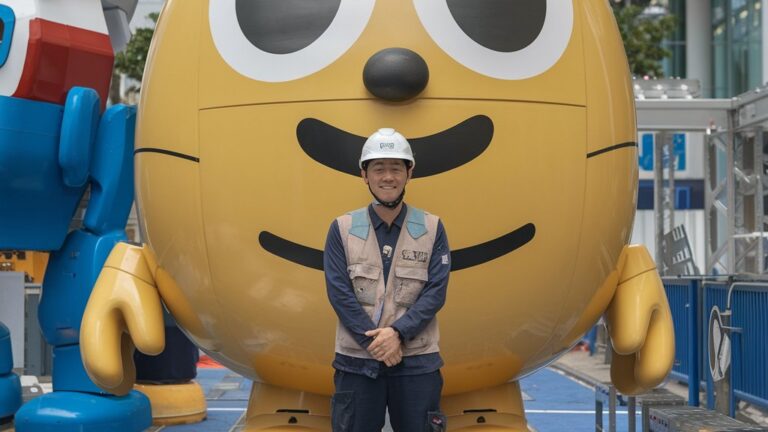Giant mascot robots are captivating fixtures at events, parades, and promotional campaigns, bringing a vibrant, larger-than-life presence to various occasions. These mechanical marvels can range from playful and whimsical to highly intricate and technologically advanced. However, like any complex machinery, giant mascot robots can experience issues over time. Understanding the decomposition process of these robots is essential for effective maintenance and repair, ensuring they continue to impress audiences without interruption.
What is a Giant Mascot Robot?
Giant mascot robots are oversized, animated figures designed to entertain and engage audiences at events. These robots are often equipped with advanced robotics, lighting, and sound systems to create an immersive experience. Their primary function is to draw attention and create memorable interactions with the public. They are commonly used in sports events, parades, promotional campaigns, and other large-scale gatherings.
Common Components of Giant Mascot Robots
- Frame and Structure: The skeleton of the robot, often made from lightweight yet durable materials such as aluminum or fiberglass, provides the foundation for the robot’s exterior and mechanical systems.
- Movement Mechanisms: These include motors, servos, and actuators that enable the robot to move its limbs, head, and other parts. Advanced models may also incorporate hydraulic systems for smoother, more fluid movements.
- Control Systems: The brain of the robot, usually a combination of microcontrollers and custom software, manages the robot’s movements, lighting, and sound effects.
- Power Supply: Giant mascot robots are powered by batteries or other power sources that provide energy to the various mechanical and electronic components.
- Exterior and Aesthetics: The outer shell of the robot, often designed to resemble a specific character or theme, is crafted from materials like foam, fabric, or plastic. This part is crucial for the visual appeal of the robot.
Decomposition Process of Giant Mascot Robots
Decomposing a giant mascot robot involves disassembling and analyzing its components to diagnose and repair issues. This process is critical for maintaining the robot’s functionality and longevity. Here’s a detailed guide to the decomposition process:
1. Initial Inspection
- Visual Check: Begin with a thorough visual inspection of the robot’s exterior and frame. Look for any visible signs of damage, wear, or loose components.
- Functional Test: Perform basic operational tests to identify any immediate issues with movement, lighting, or sound.
2. Disassembly
- Remove External Components: Carefully detach the outer shell and any decorative elements to access the internal mechanisms. This step often requires specialized tools and techniques to avoid damaging the robot.
- Access Internal Mechanisms: Open compartments or panels to reach the internal components, such as motors, wiring, and control systems.
3. Component Inspection
- Check Wiring and Connections: Inspect all wiring for signs of wear, fraying, or loose connections. Re-secure or replace damaged wires as needed.
- Test Mechanical Parts: Evaluate the condition of motors, servos, and actuators. Replace any malfunctioning or worn parts.
- Examine Control Systems: Verify the functionality of microcontrollers and software. Reinstall or update software if necessary.
4. Cleaning and Maintenance
- Clean Components: Remove any dust, debris, or dirt from the internal and external parts of the robot. Use appropriate cleaning solutions and tools to avoid damaging sensitive components.
- Lubricate Moving Parts: Apply lubrication to motors, servos, and joints to ensure smooth operation and prevent friction-related issues.
5. Reassembly and Testing
- Reassemble the Robot: Carefully reattach all external components and ensure that all parts are securely fastened.
- Conduct Final Tests: Perform comprehensive tests to verify that all functions, including movement, lighting, and sound, are operating correctly.
Preventative Measures
To prolong the lifespan of giant mascot robots and minimize the need for frequent decompositions, consider implementing the following preventative measures:
- Regular Inspections: Conduct routine inspections to identify potential issues before they escalate into major problems.
- Scheduled Maintenance: Follow a regular maintenance schedule to clean, lubricate, and test the robot’s components.
- Proper Storage: Store the robot in a clean, dry environment to protect it from dust, moisture, and other environmental factors.
- Training: Ensure that operators and maintenance personnel are well-trained in handling and servicing the robot.
FAQs
1 – What are giant mascot robots used for?
They are used for events, parades, and promotions to entertain and engage audiences with their dynamic presence.
2 – How do I know if my giant mascot robot needs maintenance?
Look for signs of wear, malfunctioning movements, or issues with lighting and sound, which indicate the need for maintenance.
3 – What tools are needed for decomposing a giant mascot robot?
Tools may include screwdrivers, wrenches, multimeters, lubricants, and cleaning supplies.
4 – Can I perform maintenance on my giant mascot robot myself?
Basic maintenance can be performed by trained operators, but complex repairs may require professional assistance.
5 – How often should I inspect my giant mascot robot?
Regular inspections should be conducted based on usage frequency, but a general guideline is to inspect after every major event or every few months.
6 – What should I do if the robot’s movement is jerky or uneven?
Inspect and lubricate the moving parts, and check for any mechanical or electronic issues.
Conclusion
Maintaining and troubleshooting giant mascot robots requires a thorough understanding of their components and the decomposition process. By conducting regular inspections, performing routine maintenance, and following a systematic approach to repairs, you can ensure that your giant mascot robot remains in optimal condition. Implementing preventative measures will help extend the lifespan of the robot and keep it performing at its best. With proper care and attention, giant mascot robots will continue to bring joy and excitement to audiences, making every event memorable.
